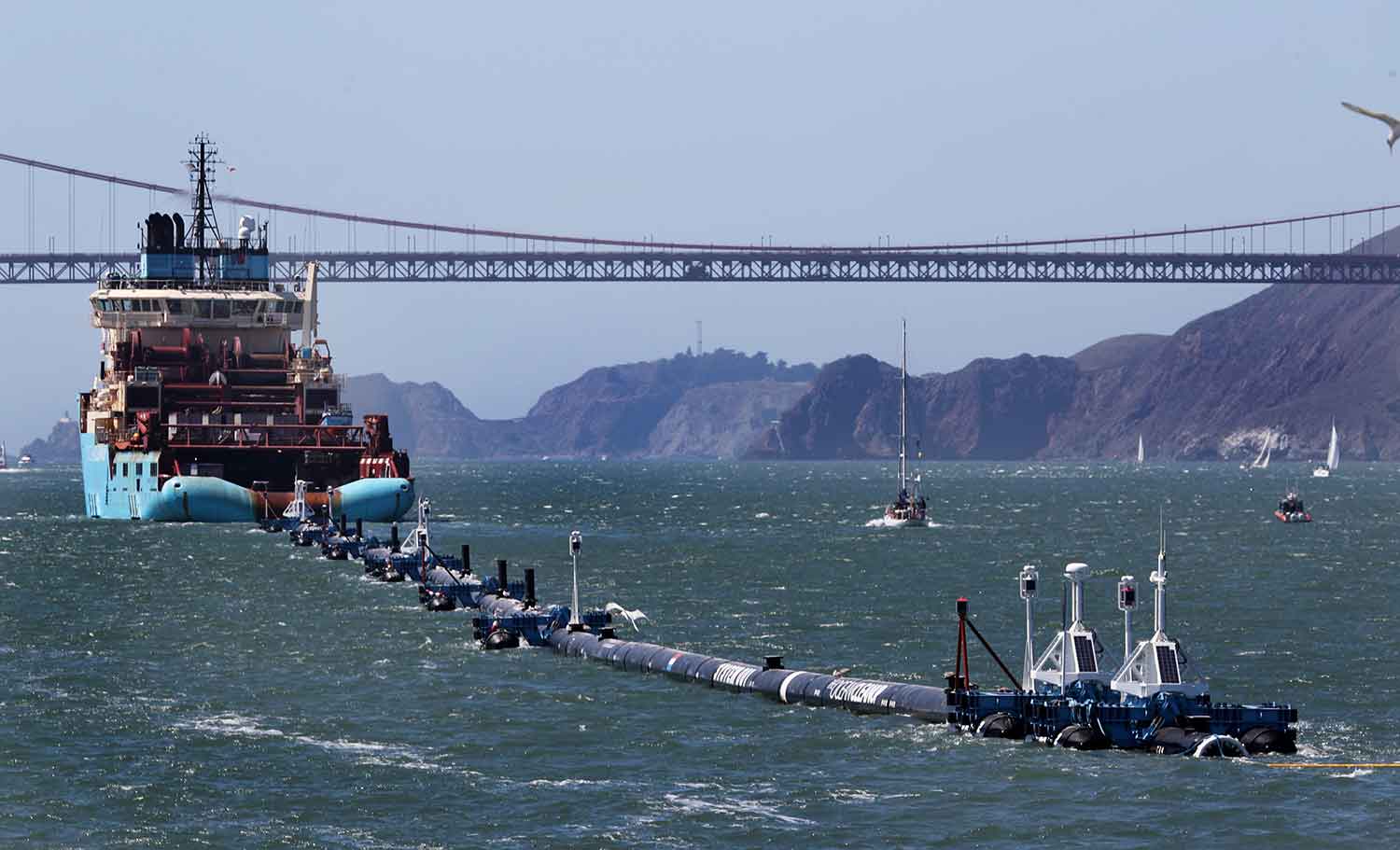Ocean Cleaning Device Succeeds in Removing Plastic for the First Time

Ocean Cleanup’s System 001 is towed out of the San Francisco Bay in San Francisco, California on Sept. 8, 2018. Ray Chavez / Digital First Media / East Bay Times via Getty Images
An enormous floating device designed by Dutch scientists for the non-profit Ocean Cleanup successfully captured and removed plastic from the Great Pacific Garbage Patch, the company announced earlier this month, as CNN reported.
Ocean Cleanup has been hard at work on creating a device to attack the plastic waste crisis for seven years, by creating a device that captures plastic in its fold like a giant arm, according to Business Insider. The company announced that it was able to capture and hold debris ranging from large cartons, crates and abandoned fishing gear — or “ghosts nets,” which are a scourge to marine life— to microplastics that are as small as one millimeter, according to an Ocean Cleanup press release.
“Today, I am very proud to share with you that we are now catching plastics,” Ocean Cleanup founder and CEO Boyan Slat said at a news conference in Rotterdam.
In 2011, at age 16, Slat came across more plastic than fish while diving in Greece and decided to devote a high school project for deeper investigation into ocean plastic pollution and why it was considered impossible to clean up. He later came up with the idea to build a passive system, using the circulating ocean currents to his advantage, which he presented at a TEDx talk in 2012.
Slat discontinued his aerospace engineering studies at TU Delft, to devote his time to developing his idea and founded The Ocean Cleanup in 2014, and shortly after, his TEDx talk went viral after being shared on several websites and on social media platforms, particularly Facebook.
“Technology is the most potent agent of change. It is an amplifier of our human capabilities”, Slat wrote in The Economist. “Whereas other change-agents rely on reshuffling the existing building blocks of society, technological innovation creates entirely new ones, expanding our problem-solving toolbox.”
The system’s success in capturing microplastics came as a welcome surprise since microplastics tend to fall to the ocean floor rather than float on the surface, according to the press release. Since microplasitcs tend to sink, Ocean Cleanup focused on large pieces of plastic.
Slat posted a picture on Twitter of collected debris along side a forsaken wheel.
“Our ocean cleanup system is now finally catching plastic, from one-ton ghost nets to tiny microplastics! Also, anyone missing a wheel?” Slat wrote
Our ocean cleanup system is now finally catching plastic, from one-ton ghost nets to tiny microplastics!
Also, anyone missing a wheel? pic.twitter.com/Oq0rkXO3TH
— Boyan Slat (@BoyanSlat) October 2, 2019
The Ocean Cleanup device is a U-shaped barrier that drops a net below the surface. As the current moves, the net traps faster moving objects that float into it. Fish, however, are able to swim beneath it.
This project has been a labour of love, as Slat and his team worked tirelessly to overcome many failures along the way.
Last year, a design flaw stopped the barrier from holding onto the plastic it captured and a 59-foot section of the barrier disconnected from the device. In its next attempt, the design team noticed that plastic was floating over the top of a cork line that was supposed to stabilise the system.
The team also noticed that the barrier, known as System 001/B was picking up speed from the ocean currents that outpaced the plastic litter. Therefore, after some rethinking and some upgrades, the device was slowed down by a parachute-anchor. That allows faster moving plastic to float into the barrier. After the parachute-anchor was on, the team fixed the corkline so very little plastic was able to pass over the top of the barrier, according to Ocean Cleanup’s press release.
“Our team has remained steadfast in its determination to solve immense technical challenges to arrive at this point,” said Slat in his statement. “Though we still have much more work to do, I am eternally grateful for the team’s commitment and dedication to the mission and look forward to continuing to the next phase of development.”
The Great Pacific Garbage Patch, which is twice the size of Texas, is a swath of plastic debris brought together by the ocean currents and kept in formation by a whirlpool of currents, as The Guardian reported.
Ocean Cleanup now wants to scale up the project so it can hold plastic for a year before collection is necessary. It has the goal of removing half of the Great Pacific Garbage Patch.
The Ocean Cleanup said in its press release that it will now start on its next iteration, System 002, a full-scale cleanup device that will endure rough ocean conditions and retain the collected plastic for long periods of time between collections. Once the plastic is collected, it will be returned to land and processed for recycling.
Of course, we must all continue to do our part — it’s not acceptable for us to continue to pollute our lands and seas just because new technology is now able to capture it. The moment to ban single use plastics and to implement better ways of doing business worldwide will be paramount if we are to eventually live in an environment that is clean and fit for future generations to come.
Source: Eco Watch
Enjoyed this article and want to know more? Here are some easy steps you can take right now…
- Book a life changing “remote healing session” with Soul Guidance with Jaime: https://www.energytherapy.biz/energy-healing-with-jaime-tanna/
- Join Jaime’s fantastic 1 year Energy Coaching Program: Total Frequency Shift — Discover Radiant Health & Freedom
- Sign up for Jaime’s exciting new substack at https://energytherapy.substack.com/https://energytherapy.substack.com/



















































